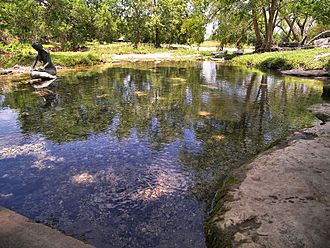Salado Springs facts for kids
Quick facts for kids Salado Springs |
|
|---|---|

Salado Springs
|
|
| Location | Salado, Texas, U.S.A |
| Spring source | Faults along Balcones Escarpment |
| Elevation | 560 ft (171 m) above sea level |
| Type | Karst springs |
| Provides water for | Salado Creek |
| Magnitude | 2 |
| Discharge | 16.2 ft3/s (460 L/s) |
Salado Springs are a group of five natural springs located in the town of Salado, Texas, in the United States. These springs are about 48 miles (77 km) north of Austin. Even though 'salado' means 'salty' in Spanish, these springs are actually fresh water! They were probably named after Salado Creek, a nearby stream.
Contents
Where Are Salado Springs Located?
The Salado Springs are found in an area called the Balcones Fault zone. This is a place where the Earth's crust has cracked, creating faults. The water from the springs comes up to the surface through these cracks. It's like the water is pushed up by natural pressure, similar to how water comes out of a hose when you turn on the tap.
The water for these springs mostly comes from an area several miles to the southwest, in Williamson County. Here, several faults meet with Salado Creek, helping to feed the springs.
How Much Water Flows from the Springs?
The bigger springs in the area include Robertson Springs, Big Boiling Spring, Elm, Benedict, and Anderson springs. The last three are located a bit further downstream (east) from the others. In the 1980s, all the springs together released about 122 gallons (460 liters) of water every second! That's a lot of water!
What Makes This Area Special for Nature?
The Balcones Fault Zone, where Salado Springs are located, is a special dividing line for different plants and animals. For example, the California Fan Palm (Washingtonia filifera) usually grows only to the west of this fault line. This shows how geology can affect where different species live.
A Look Back: The History of Salado Springs
The area around Salado Springs has been important to people for a very long time.
Who Lived Here First?
For many years, the Tawakoni Indians lived near the springs. Even before them, ancient people called Paleo Indian peoples lived here for thousands of years. The springs were likely a vital source of fresh water for these early communities.
Early Explorers and Settlers
A Spanish explorer named Juan Antonio Bustillo y Ceballos probably visited the springs in 1732. He was traveling through the region at that time. Later, in 1851, a man named Archibald Willingham settled the area.
The springs soon became a well-known stop for travelers. It was a popular place for stagecoaches to stop and rest. It was also a stop along the famous Chisholm Trail, which was used to drive cattle.
The Dam and the Springs
In 1863, a dam was built near the springs. The dam was used to power a mill, which grinds grain. However, building the dam caused some of the springs to become flooded. This meant they were covered by water and couldn't flow freely.
After some time, in 1878, a court ordered that the dam be lowered. This helped the springs flow normally again.

